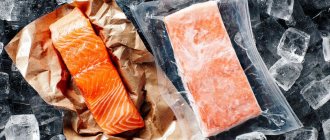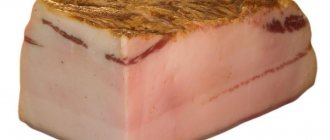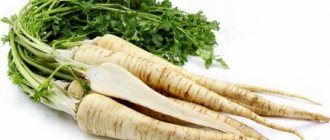Pork lard is a controversial product. But there are still some benefits from it for the body. There are many ways to prepare lard: it is salted, boiled, smoked, prepared in brine, fried, greased in a frying pan. They even treat colds. Arachidonic acid contained in lard is responsible for the normal functioning of the heart, kidneys and brain.
How to properly store lard so that it does not lose its taste and beneficial qualities depends on the cooking method. We will talk about storage methods and conditions, and also provide some useful tips.
How to choose good lard
The most important thing is to choose the right bacon from the beginning. Fresh lard is always snow-white in color. No weird urea smell. Has a pleasant smell. If the bacon is yellow in color, its smell leaves much to be desired.
Then there is no need to buy such bacon, this indicates that it is very old, or the product has simply deteriorated. The height of the correct piece should not exceed six centimeters. Fresh lard is soft and can be pierced with a toothpick without much effort.
You should always pay attention to the thickness of the skin. The thicker it is, the tougher the lard. Therefore, when choosing lard, you need to look for one whose skin is thinner.
Calorie content
People get better from pork fat. That's what people say. If you think that the calorie content of lard is higher than vegetable oil, then you are mistaken.
- Lard - 800 kcal.
- Olive oil - 885 kcal.
Salads with olive or sunflower oil do not cause indignation among young girls, but they snort at the thought of bacon. By the way, sunflower oil contains 60 kcal more than salted lard. At the same time, there is no fiber in vegetable oil. The pure fat content in 100 grams of lard is much less than in the same amount of vegetable fat. So think logically: it’s better to eat 30 grams of bacon or a salad with olive oil dressing.
Another thing is that few people will swallow lard without bread. And bread is pure carbohydrates that are not always burned in time. You should eat animal fat in moderation. Fresh bacon contains many useful substances. So don’t be afraid and eat to your health, but remember in moderation.
Proper storage of fresh lard
It must be remembered that fresh and smoked lard, as well as salted lard, have different storage methods and different shelf life.
Fresh lard is stored only at sub-zero temperatures, so keeping it in the freezer would be ideal. The life of fresh lard that has not been frozen is 24 hours. The shelf life is very short. If you freeze fresh bacon, it is good for consumption up to six months.
- For its subsequent preparation, it is better to cut the bacon into small portions.
- This is necessary in order to cook a small part of it, since lard cannot be frozen and thawed several times.
If in the future you need to salt the bacon, then freeze it in the same piece that will be salted.
Common Mistakes
One of the common mistakes made by consumers is trying to store bacon in inappropriate conditions. Unfortunately, the belief that salt as a preservative preserves the product for a long time without spoiling in room conditions leads many to a hospital bed with food poisoning.
Other factors to consider:
- The room where lard is stored should be dark. Light, and especially the sun's rays, significantly reduce its shelf life.
- If the finished bacon is stored in the cellar, it must be dry - high humidity provokes rapid mold growth and spoilage.
Proper storage of hot smoked bacon
At temperatures up to +5, such lard can be stored for a short time, up to five days.
- But the housewives managed to extend the life of this type of bacon.
- If you soak a cotton cloth in a strong solution of salt and water and wrap it around it.
- Next, you need to wrap the lard in paper and put it in the refrigerator.
- Thanks to this simple action, the shelf life of lard increases to 21 days.
- At high sub-zero temperatures in the freezer, the shelf life is up to one year.
- To store it in the freezer, just wrap it in several layers of cling film.
To prepare such lard, it is smoked with hot smoke for up to one hour at temperatures up to 100 degrees. ·
General recommendations
Here are some rules that need to be followed:
- The maximum temperature should not exceed 5-7 C.
- The location must be hidden from ultraviolet radiation (direct sunlight).
- When storing lard in the cellar, ensure good air circulation and avoid high humidity.
- Long-term storage of bacon is possible only after its pre-processing (salting, smoking, rendering fat). You can keep it fresh for some time at a low temperature (refrigerator, freezer).
- You should not leave foods with a strong aroma nearby, as lard will absorb it. This will change its taste and smell.
- Before putting the bacon into the refrigerator, the piece must be thoroughly dried.
Solid animal fat can be stored in jars, plastic containers or wooden boxes. In the last 2 options, it is recommended to pre-wrap it with cling film or paper.
Proper storage of cold smoked lard
This is a rather long and labor-intensive smoking process. Smoking occurs with cold smoke at temperatures up to 30 degrees for 72 hours. The undeniable advantage of this type of lard is that its shelf life is 3 years at sub-zero temperatures.
When storing such lard, it must be wrapped in thick paper, so it will remain fresh at temperatures up to +5 throughout the year.
You should avoid the proximity of smoked bacon to products that have a specific strong odor, so that the bacon does not absorb this smell.
Transportation of smoked meats
If you need to transport smoked lard over long distances, you can use the following methods:
The easiest way is to wrap each piece in wrapping paper. In such a container, the product will breathe and remain fresh even in hot weather for up to 3 days.
Cooler bag. Ideal for transportation. Thanks to special batteries, the cool temperature in the bag will allow you to deliver the product absolutely fresh.
Sealed metal containers and dry ice. This design makes it possible to transport products over long distances.
Proper storage of rendered lard
Rendered lard is often used for frying and baking. This product can be stored at above-zero temperatures or in the freezer compartment of the refrigerator.
Shelf life up to 3 years.
- In order to melt the lard, you need to cut it and put it in a pan.
- Turn on the lowest heat.
- After separating the fat, it must be strained through a sieve.
- Then pour the resulting white liquid into a clean jar and cover with a lid.
Proper storage of salted lard
Lump salted lard
- It can be stored in two ways: in the refrigerator and in the freezer.
- At temperatures up to +5 degrees, its shelf life is from four to six weeks. If lard is frozen, it can be stored for a whole year.
- When salting lard, it is important to know that it is difficult to oversalt it, since this product will take in exactly as much salt as it needs.
- To salt a kilogram of lard, one hundred grams of salt will be enough.
- Place lard, completely rubbed with salt, into a bowl or container. And send it to a cool place for 3 days.
If after taking the first sample the lard is not salted enough, then you need to leave it to salt for the same period. This is the most basic way to salt lard.
To make the lard more interesting and have its own unusual aroma, you can add spices. Mix one hundred grams of salt with 3 teaspoons of black pepper. Slice half a head of garlic.
Make cuts in the bacon with a knife and put garlic in them. Then generously sprinkle the lard with a mixture of pepper and salt and place it in a cool place. At your discretion, you can add those spices that you prefer. Home-salted lard is in no way inferior to store-bought, and as a rule, even tastier.
Pickling
Regular table salt perfectly extracts excess moisture from meat; in addition, the storage of salted meat is facilitated by the fact that salt is an antibacterial substance. There are two main methods of salting meat - dry and wet salting. By rubbing the meat with salt and allowing it to absorb moisture, you will get a dry product. The process is quite simple - just mix the meat with salt in the right proportions, but various herbs and spices are often used to give the meat a pleasant taste. With wet salting, meat is salted in brine. To make this meat tastier, you can add brown sugar or honey to the brine. Another traditional process called biltong involves marinating meat in vinegar before salting and drying.
As a rule, corned beef sold in stores contains certain additives that improve the taste and appearance of the finished product - but if you make corned beef yourself, you can easily get by by salting the meat with pure salt without any additives. Of course, you can buy a special curing salt that contains about 6 percent sodium nitrite, a chemical that provides some protection against botulism - but if you exceed the recommended dosage, it will not end well for you. The recommended amount of salt for preparing brine is 30 grams per liter of water.
Proper storage of bacon in brine
Its shelf life is at temperatures up to + 5 degrees, about a month. If you freeze it, the shelf life will increase to 12 months.
- To prepare it, you will need to mix half a liter of water and one hundred grams of salt. Bring the resulting water to a boil.
- Place a few black peppercorns in a three-liter jar. We put 2 bay leaves in it.
- Rub the bacon with chopped garlic and place it in a jar without compacting it. Fill with cooled water.
- We do not cover the jar with anything. And we just leave her in the room for a few days.
- Then cover the jar with a simple nylon lid. Place in the refrigerator for seven days.
- A week later, we take out the salted lard from the jar. We blot with a dry cloth and wrap in parchment.
The good thing about lard is that it is a shelf-stable product. But you should not forget that over time it loses its beneficial properties. Therefore, it is better to consume it as soon as possible.
What is the product
Essentially, lard is subcutaneous animal fat, a nutritional reserve deposited by the animal body during periods of increased nutrition.
Composition of this fat:
- Almost entirely - triglycerides containing saturated fatty acid residues, including oleic, linoleic, linolenic, and most importantly, arachidonic acid, which are beneficial to the body. It plays an important role in cholesterol metabolism, the functioning of the hormonal system, and helps the body turn on defense mechanisms when fighting bacteria and viruses.
- In small quantities - minerals (mainly selenium and zinc).
- Also some vitamins - B4, D, E.
The product can be stored for a long time in salted, smoked or boiled form. Does not lose its consumer properties during long-term freezing and can be preserved.











